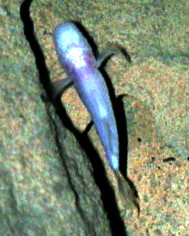Southern cavefish facts for kids
Quick facts for kids Typhlichthys subterraneus |
|
|---|---|
 |
|
| Conservation status | |
| Scientific classification | |
| Kingdom: | |
| Phylum: | |
| Class: | |
| Order: |
Percopsiformes
|
| Family: |
Amblyopsidae
|
| Genus: |
Typhlichthys
Girard, 1859
|
| Species: |
T. subterraneus
|
| Binomial name | |
| Typhlichthys subterraneus Girard, 1859
|
|
The southern cavefish (Typhlichthys subterraneus) is a unique fish that lives only in underground caves and waters. It is a type of cavefish found in the eastern United States. This fish is special because it has adapted to life in complete darkness.
Contents
What is the Southern Cavefish?
The southern cavefish is one of five types of fish in the Amblyopsidae family that live only in caves. These fish are called troglobites, meaning they are specially adapted to underground life. The southern cavefish is currently the only member of its group, Typhlichthys. However, scientists think it might actually be a "cryptic species complex." This means there could be several very similar species that look alike but are genetically different.
How was it Discovered?
A scientist named Charles Frédéric Girard first described the southern cavefish in 1859. He found it in a well near Bowling Green, Kentucky. Later, other scientists thought they had found different types of Typhlichthys based on small differences. For example, T. osborni and T. wyandotte were described.
However, in 1957, a big review of the Typhlichthys group decided that all these populations were actually the same species, T. subterraneus. This was because they couldn't find clear differences based on how the fish looked.
Are There Other Types of Southern Cavefish?
Even though they look similar, recent studies using genetic information suggest that T. subterraneus might indeed be a group of hidden species. For example, the population found in the Ozark region might be a separate species called T. eigenmanni.
Also, a group of southern cavefish in Sloans Valley Cave, Kentucky, seems different from those in Tennessee. This group might also be a new, undescribed species. Scientists continue to study these fish to understand them better.
Where Does the Southern Cavefish Live?
The southern cavefish gets its name because it lives in the southern parts of the United States. You can find it in underground waters in states like Indiana, Alabama, Kentucky, Georgia, Missouri, Tennessee, Arkansas, and Oklahoma.
The areas where it lives are separated by the Mississippi River. These areas include:
- The Ozark plateau in central and southeastern Missouri and northeastern Arkansas.
- The Cumberland and Interior low plateaus in northwest Alabama, northwest Georgia, central Tennessee, and Kentucky.
- Southern Indiana.
These fish usually live alone in their underground homes. They are often isolated from other groups of cavefish.
Ecology and Conservation
The southern cavefish mostly lives in calm, still pools of water inside caves. Sometimes, they can also be found in streams near underground water sources.
What Do They Eat?
These cavefish mainly eat small aquatic bugs. Their diet includes creatures like amphipods and isopods. To survive when food is scarce, their bodies slow down their metabolism. This means they use less energy, which helps them live through times with little food.
Reproduction and Life Cycle
The southern cavefish does not have many babies. A female usually lays fewer than 50 eggs. This low number makes it hard for their populations to recover if they face a decline.
When the young fish hatch, they are cared for in the female's gill chamber. It takes about two years for a southern cavefish to become old enough to reproduce. Their average lifespan is around four years.
Why is the Southern Cavefish Threatened?
The southern cavefish is listed as "Near Threatened" on the IUCN Red List. This means it could become endangered in the future if things don't improve.
Their numbers and the areas where they live have been shrinking. This decline is likely due to several environmental problems:
- Pollution: Water pollution can harm their underground habitats.
- Lowering Water Tables: If the underground water levels drop, their homes can dry up.
- Flooding: Reservoirs flooding can change their habitats.
- Cave Vandalism: Damage to caves can also hurt the fish.
Different states have placed the southern cavefish under various conservation plans. Protecting their unique underground homes is important to help these special fish survive.


